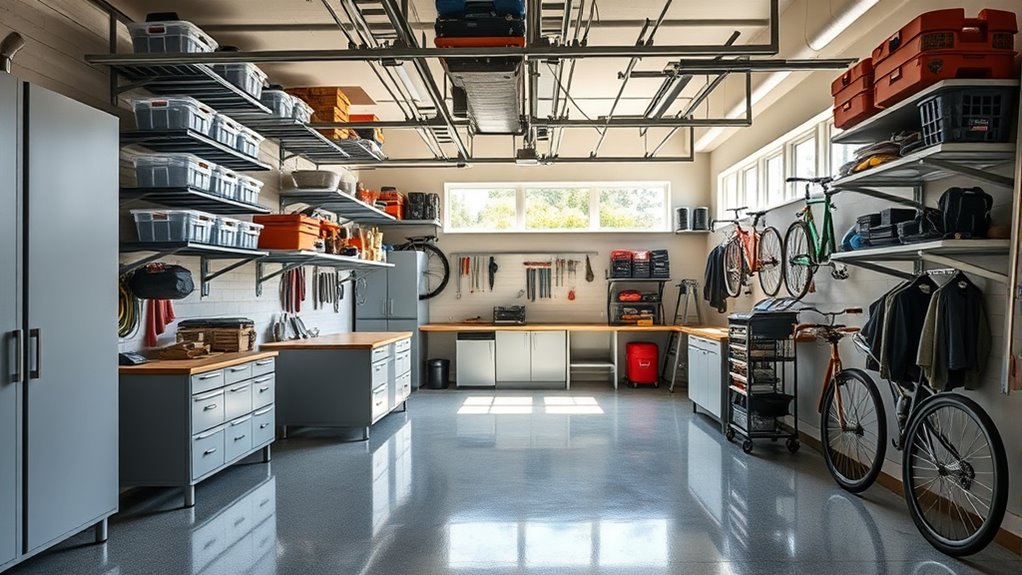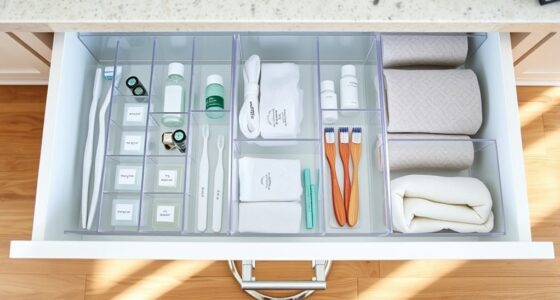To reclaim 50% more space in your garage, start by evaluating your current layout and storage needs. Use modular, customizable solutions like cabinets, shelves, and pegboards to maximize wall space and add vertical and overhead storage for seldom-used items. Create dedicated zones for tools, sports gear, and seasonal items to keep everything organized and accessible. Implementing these strategies can transform your garage into a clutter-free zone — keep exploring to discover how to optimize every inch.
Key Takeaways
- Implement vertical storage solutions like wall-mounted shelves and pegboards to maximize unused wall space.
- Use overhead racks and ceiling-mounted bins for seldom-used or bulky items, freeing floor space.
- Divide the garage into dedicated zones for specific items, enhancing accessibility and reducing clutter.
- Opt for modular, reconfigurable storage systems tailored to your needs for flexible organization.
- Regularly reassess and maintain your system through scheduled cleanups and labeling to sustain space efficiency.
Assessing Your Garage’s Current Layout and Storage Needs

Before you start organizing, it’s essential to evaluate your garage’s current layout and storage needs. Look around and identify what items take up the most space and how often you use them. Notice any cluttered areas or zones where items are haphazardly stored. Determine which items are seasonal, rarely used, or need quick access. Measure your garage’s dimensions and note fixed features like doors, windows, and utility connections. Think about your ideal setup: Do you need more vertical storage, designated zones, or space for larger tools? This assessment helps you understand what’s working and what isn’t, so you can create a tailored plan that maximizes your space and enhances functionality. Taking these steps now saves time and effort later. Additionally, considering multi-functional furniture and vertical storage solutions during your assessment can further optimize your available space. Conducting a thorough storage needs analysis is essential to identify the most effective organization strategies tailored to your specific garage layout. For example, evaluating your current use of wall space can reveal opportunities for installing overhead storage that free up floor area, especially when paired with adjustable shelving for flexible organization. Implementing proper lighting can also improve visibility and make your garage more user-friendly.
Choosing the Right Modular Storage Solutions
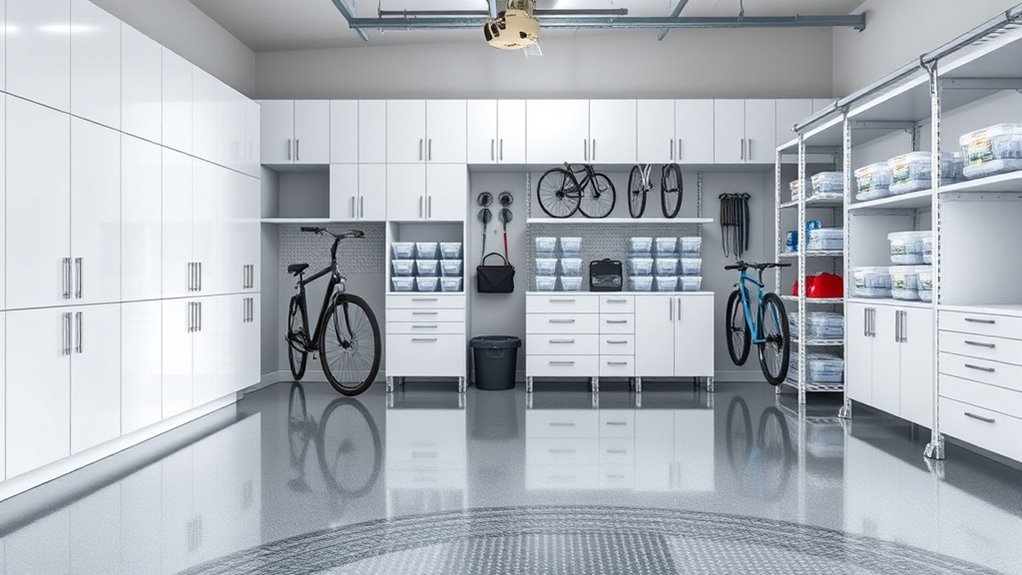
Once you’ve assessed your garage’s layout and storage needs, the next step is selecting modular storage solutions that fit your space and lifestyle. Choose options that are customizable, durable, and easy to reconfigure as needs change. Consider your primary items—tools, sports gear, seasonal decorations—and select units that accommodate their size and quantity. Modular systems include cabinets, shelving, and pegboards, which can be combined to maximize space and accessibility. Here’s a quick overview:
| Storage Type | Best For | Key Feature |
|---|---|---|
| Wall-mounted units | Small tools, accessories | Space-saving, easy access |
| Stackable bins | Seasonal items, small parts | Customizable, clear labels |
| Free-standing cabinets | Heavy tools, bulky items | Heavy-duty, lockable |
Choose solutions that suit your storage priorities and make future adjustments simple. Additionally, selecting modular storage systems that can be reconfigured over time allows your garage to adapt as your needs evolve.
Vertical and Overhead Storage Techniques
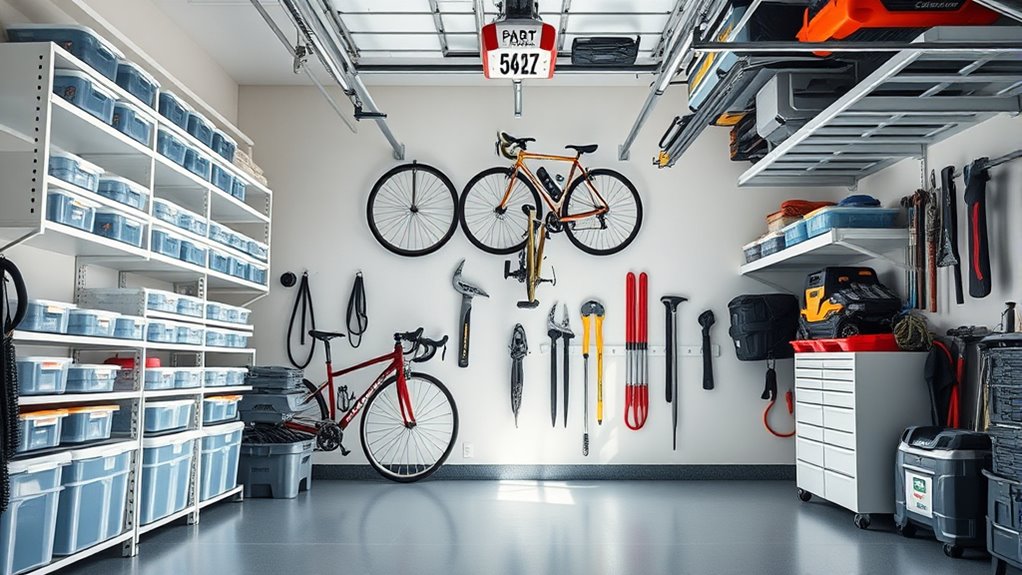
Maximizing vertical and overhead space is one of the most effective ways to free up valuable floor area in your garage. Use wall-mounted shelves and pegboards to keep tools, sports equipment, and smaller items organized and off the ground. Install ceiling-mounted racks or tracks to store larger items like bikes, ladders, and seasonal gear. Overhead storage bins or cabinets can hold seldom-used items, freeing up prime floor space. Guarantee heavy items are stored securely and within easy reach, while lighter, infrequently accessed items can be placed higher up. Use clear bins for visibility and label everything to simplify retrieval. By leveraging vertical and overhead storage, you make the most of your garage’s height, creating a cleaner, more accessible space. Incorporating automation in organization systems can further optimize space management and improve overall efficiency.
Implementing Zone-Based Organization Systems
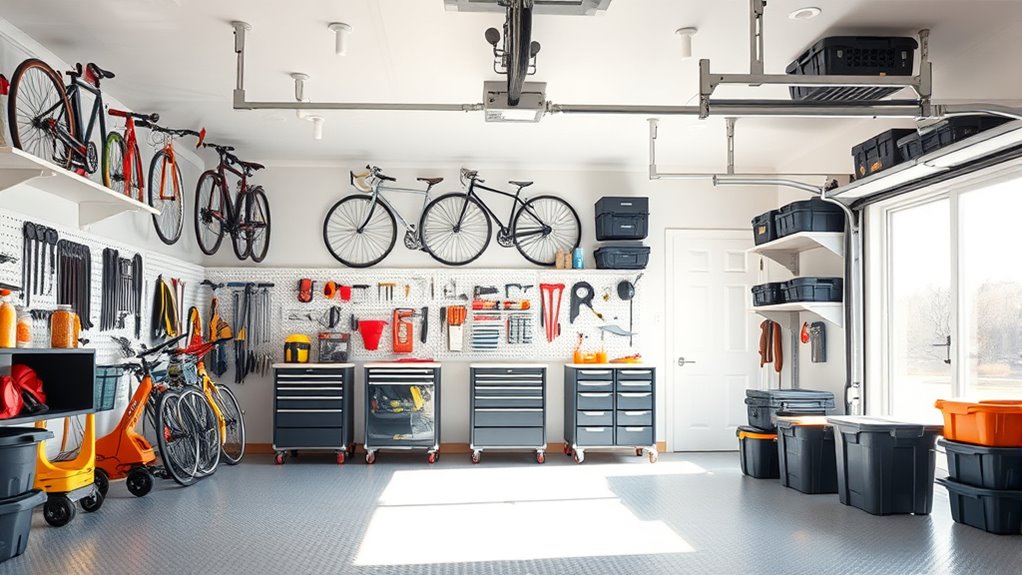
Implementing zone-based organization systems transforms your garage into a more functional space by grouping similar items together. Start by dividing your garage into dedicated zones based on usage and item types—tools, sports equipment, gardening supplies, or seasonal decorations. This approach reduces clutter and makes it easier to find what you need quickly. To further enhance accessibility, consider smart storage solutions that adapt to your specific needs. Assign clear boundaries for each zone and use labels or color-coding to reinforce organization. Keep frequently used items in accessible areas, while less-used items are stored further away. Incorporate shelves, hooks, or cabinets within each zone to maximize space. Additionally, considering the use of storage containers can help keep items organized and prevent clutter from spreading. Using custom storage solutions tailored to specific zones can further optimize space and accessibility. Implementing space-saving techniques such as vertical storage or multi-purpose furniture can also enhance overall efficiency. By creating these organized zones, you streamline your workflow, minimize search time, and prevent clutter from spreading. Additionally, Kia Tuning options like suspension upgrades and custom storage solutions can help optimize space and functionality in your garage or workshop. This targeted approach makes maintaining a tidy garage much simpler and more effective in the long run.
Maintenance Strategies for Long-Term Clutter Control

Maintaining the organization you’ve established requires consistent effort and strategic habits. To keep clutter at bay, set aside a few minutes weekly to reassess your garage. Return items to their designated zones and discard or donate what you no longer need. Create a simple system for ongoing maintenance, like labeling bins and shelves, so everything stays in its place. Avoid letting clutter accumulate by addressing small messes immediately. Regularly review your storage solutions to ensure they still meet your needs, adjusting as necessary. Keep tools, seasonal items, and sports equipment organized and accessible. Establish routines that make tidying up part of your weekly schedule. Family dynamics can significantly influence how effectively you maintain your space, so consider involving family members in your organizational efforts. Consistency is key; small, deliberate actions now make long-term clutter control achievable. Additionally, staying informed about park operating hours can help plan maintenance or cleaning days during less busy times. Implementing maintenance strategies such as scheduled cleanups can further enhance your clutter control efforts, especially by utilizing labeled storage bins for easy identification and retrieval.
Frequently Asked Questions
How Long Does the Garage Organization Process Typically Take?
The garage organization process usually takes between a few hours to a full day, depending on the size of your space and the amount of clutter. You’ll want to set aside enough time to sort, declutter, and install storage solutions. With a clear plan and some help, you can streamline the process. Remember, taking your time guarantees everything is organized efficiently and lasts longer.
Can This System Accommodate Large or Bulky Items?
You wonder if this system can handle large or bulky items. The good news is, yes, it’s designed to support big things like ladders, bikes, or storage bins. You can customize the setup with sturdy shelves, hooks, and brackets that hold heavy or oversized items. This flexibility guarantees you can organize everything efficiently, maximizing space and keeping your garage tidy without sacrificing room for larger belongings.
Is Professional Installation Recommended or DIY Feasible?
Imagine transforming your cluttered garage into a sleek, organized space. You wonder if you should tackle this project yourself or bring in experts. While DIY is possible with clear instructions and basic tools, professional installation guarantees precision, especially for heavy or bulky items. If you’re confident in your skills, you might give it a shot. Otherwise, investing in pros guarantees a flawless, space-maximizing result you’ll enjoy daily.
What Are the Cost Considerations for This Organization System?
When evaluating costs, consider both the initial investment and long-term savings. You’ll need to budget for the system itself, which varies based on size and features. Professional installation might add to your expenses but guarantees proper setup, reducing future repairs. DIY installation saves money but requires time and effort. Factor in potential resale value and organization benefits to determine if the investment aligns with your budget and goals.
How Often Should the System Be Reassessed for Effectiveness?
You should reevaluate your garage organization system every 6 to 12 months. Regular checks help you identify clutter buildup, worn-out storage solutions, or inefficiencies. By evaluating its effectiveness regularly, you ensure the system continues to reclaim maximum space and stay tailored to your needs. Keep an eye on how well it’s working, make adjustments as needed, and stay proactive to maintain a tidy, functional garage environment.
Conclusion
Don’t let clutter hold you back—using a smart, modular system can free up 50% more space in your garage. Some might think it’s complicated or costly, but with simple zoning and vertical storage, you’ll see immediate results. Stick with it, and long-term organization becomes easier than ever. Reclaim your garage today and enjoy a cleaner, more functional space—trust me, it’s worth the effort!
